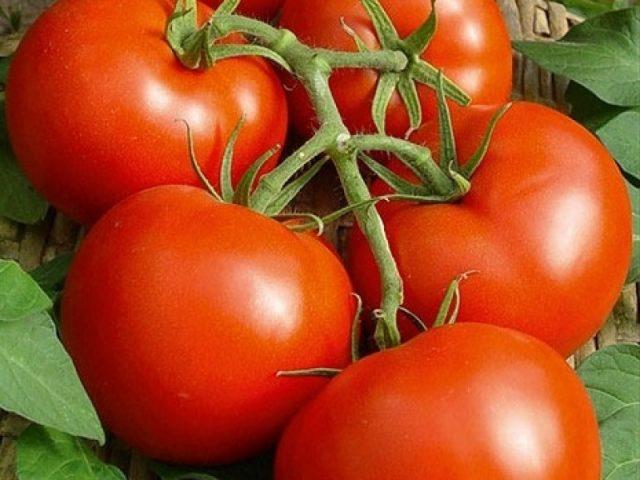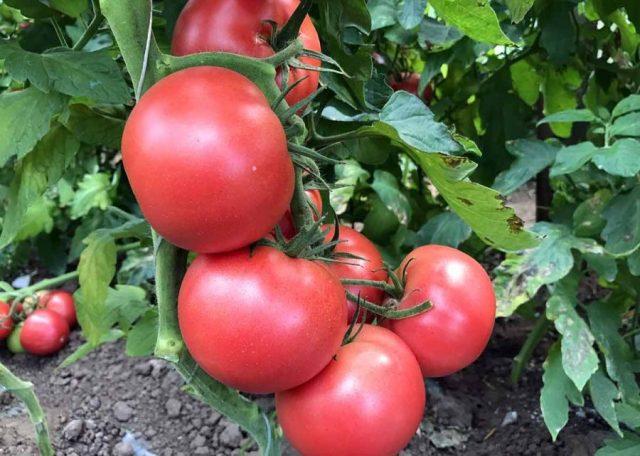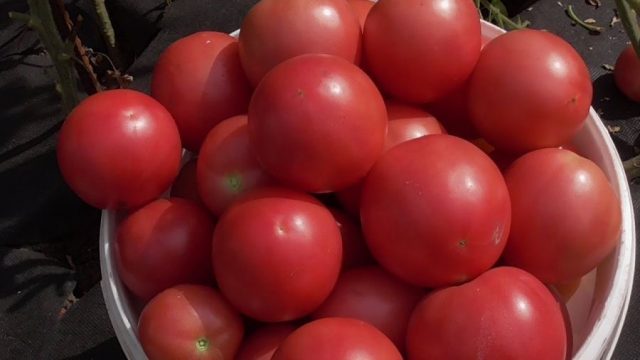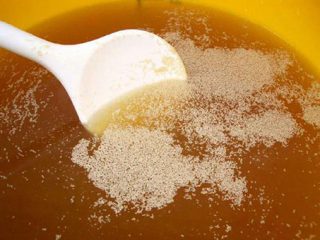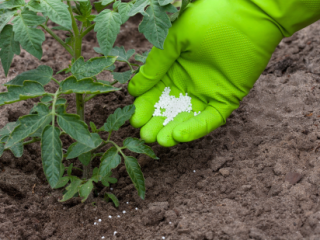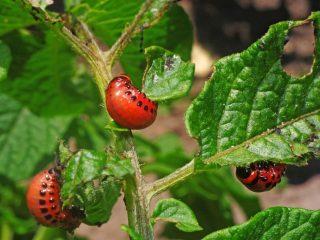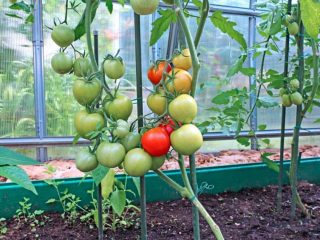Content
The description and treatment of tomato cladosporiosis is worth studying when spots appear on the leaves of the bushes. The disease can be eliminated; chemicals and home remedies help to cope with it.
Description and photo
Cladosporium blight, or tomato brown spot, is a disease caused by the pathogen Cladosporium fulvum. The fungus enters the plant and begins to germinate in the tissues, withstands both heat and cold, constantly evolves and develops resistance to fungicides. In winter, pathogenic spores become inactive, but with the onset of spring, the pathogen wakes up again and begins to harm vegetable bushes.
Cladosporiosis affects tomatoes in open ground and in greenhouses. Symptoms of the disease can usually be noticed in mid-summer.The disease develops as follows:
- at the initial stage, light areas appear on the leaves, and a grayish coating forms on the reverse side;
- the surface of the plates becomes denser and acquires a velvety texture, the spots darken;
- the leaves fall off and the tomato quickly dies.
The fungus does not affect the stems of tomato bushes and fruits. But in the later stages of the development of the disease, they also become covered with spots. Due to fallen leaves, the tomato cannot carry out photosynthesis normally, and other parts of it lack nutrients. If spots appear not only on the plates, but also on the fruits, then it is no longer possible to save the affected plant.
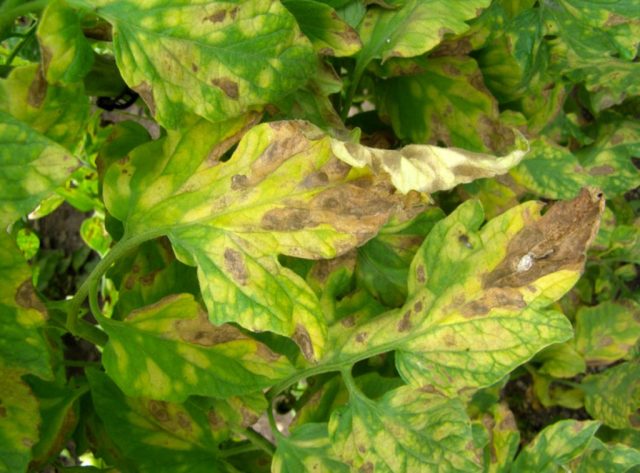
The causative agent of cladosporiosis is able to withstand unfavorable conditions for up to ten months
Signs of occurrence
Brown spot on tomatoes manifests itself with vivid symptoms and is difficult to miss. The development of the disease is indicated by:
- light green or yellowish markings on the leaves, gradually becoming darker;
- loose plaque that appears first on the back and then on the outside of the plates;
- drying and falling of leaves;
- brown raised spots on ripening tomatoes;
- rotting and wrinkling of the skin of the fruit.
It is necessary to begin treatment for cladosporiosis at the earliest stages of the development of the disease. It is quite difficult to cope with an advanced disease, and the infection spreads very quickly throughout the plantings.
Reasons for appearance
Cladosporiosis is of fungal origin and develops on tomatoes due to spores of the pathogen entering the plant. Most often the disease is provoked by:
- increased soil moisture in the greenhouse or on the site;
- excess nitrogen in the soil;
- too dense planting of bushes;
- lack of potassium and phosphorus in the soil;
- air temperature is more than 25 ° C with humidity above 90%.
Cladosporiosis spores can fall on tomatoes with the wind; they are often transferred to the plant from the gardener’s clothing or from dirty gardening tools. The likelihood of developing the disease increases if there is damage to the leaves.
Ways to combat cladosporiosis of tomatoes
Brown leaf spot of tomatoes is treated in several ways. Chemicals and homemade compounds, as well as biologically based products, can be used for therapy.
Agrotechnical methods
When cladosporiosis appears on tomatoes, it is necessary to fight the disease, first of all, using agrotechnical methods. They will stop the development of the disease even before the start of the main treatment. In particular, it is recommended:
- immediately remove completely wilted plants from the site or from the greenhouse;
- trim off the affected parts of bushes that are not too badly damaged;
- thin out the plantings and leave at least 40 cm of free space between individual plants;
- reconsider the approach to irrigation and normalize soil moisture;
- Apply fertilizing containing potassium and phosphorus.
If tomatoes grow in a greenhouse, then as part of the treatment it is necessary to reduce the humidity level to 70-80%. In the greenhouse, you need to organize high-quality ventilation and provide the bushes with a stable flow of fresh air.
Folk remedies for tomato cladosporiosis
You can treat tomato cladosporiosis in the very first stages with home remedies. But if the disease has severely affected the bushes, it is better to abandon such drugs and immediately switch to chemicals.
Milk serum
Whey solution has a good effect against the causative agent of cladosporiosis. To prepare it, you need to fill 1 liter of product with 10 liters of clean lukewarm water. The solution is thoroughly mixed until a homogeneous liquid is obtained, and then sprayed over the plantings.
Spraying is carried out every ten days until symptoms disappear. If the signs of cladosporiosis progress, it is better to interrupt treatment in the middle and move on to more effective methods.
Milk and iodine solution
Pharmaceutical iodine helps cure tomatoes from cladosporiosis. The processing tool is done like this:
- Add 4 ml of iodine tincture to 1 liter of natural milk.
- Dilute with clean water to a volume of 10 liters.
- Mix properly.
The resulting preparation is used for spraying tomato bushes. The treatment will be more effective if the solution gets not only on the outer, but also on the lower surface of the leaves. Treatments are carried out every ten days until the development of cladosporiosis stops.
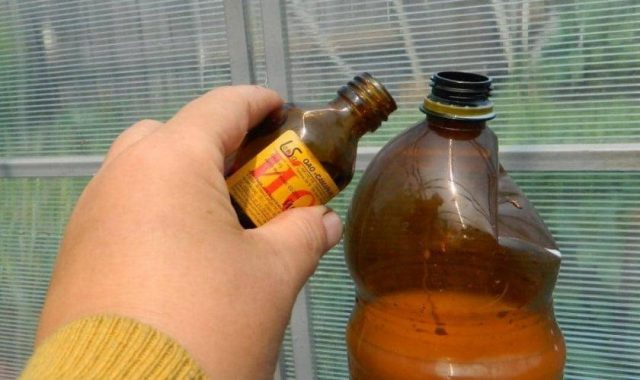
Iodine can burn plant leaves, so when preparing the solution it is important to add the tincture in a small volume
Green infusion
A plant-based infusion works well against tomato cladosporiosis, or brown olive spot. The scheme for its preparation looks like this:
- Nettle, burdock and quinoa greens are chopped in equal quantities.
- Fill a plastic bucket 1/3 full with plant materials.
- Add a glass of wood ash to the ingredients.
- Pour in 10 liters of clean lukewarm water.
- Leave the bucket in the sun for 3-4 days.
After the period has passed, it is necessary to strain the resulting infusion. Concentrated product in a volume of 1 liter is diluted in a bucket of clean water. The drug is used for spraying tomatoes; treatments are carried out three times a month.
Chemicals
It is better to treat tomatoes against cladosporiosis in the presence of well-defined signs of the disease using chemicals. When using them, precautions must be taken, but the beneficial effect of such products is very high.
Acrobat MC
A local-systemic fungicide penetrates the tissues of the cladosporiosis fungus and prevents the formation of new spores. To prepare a solution for treatment, you need to mix 20 g of the drug in 4 liters of clean water. The resulting product is used for spraying for three days; it is best to carry out the treatment immediately.
If cladosporiosis has affected only the lower leaves of the bushes, one application of the drug Acrobat MC is usually sufficient. If the middle tier plates are damaged, it is recommended to spray again after two weeks.
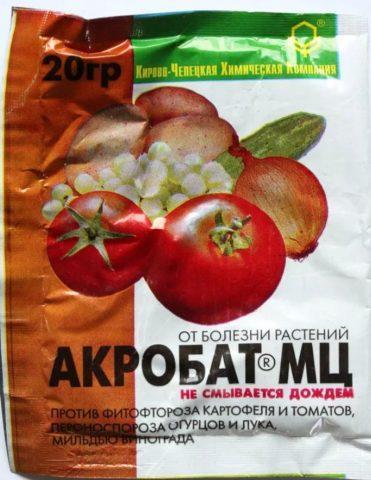
Tomatoes can be treated with Acrobat MC for treatment purposes no later than a month before harvesting.
Quadris
A popular chemical drug contains the active substance azoxystrobin. When it comes into contact with tomato leaves, it suppresses the processes of cellular respiration in the fungus and prevents the latter from multiplying. For treatment, you need to stir about 6 ml of the suspension in 5 liters of water and spray the tomato bushes.
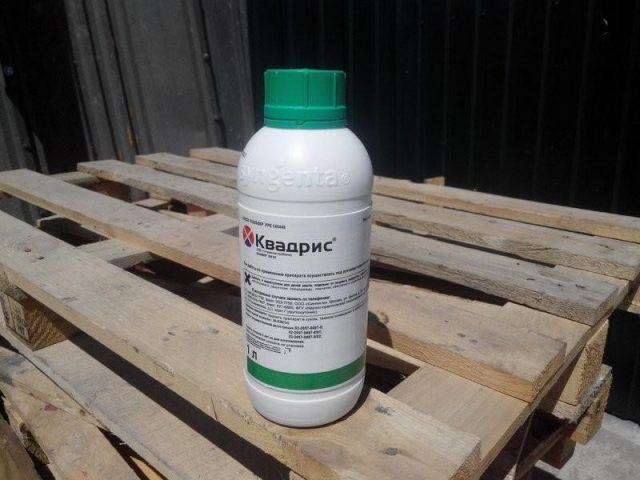
The consumption of the drug Quadris is small - when treating 100 m2 of plantings, it takes only 5 liters of solution
The drug effectively suppresses the fungus and provides tomatoes with protection for 1-4 weeks. The product does not pose a danger to the soil because it quickly breaks down into non-toxic compounds. Quadris can be used for treatment only five days before harvest.
Biological preparations for tomato cladosporiosis
Treatment of tomatoes against brown spot with moderate severity of symptoms is often carried out with biological products. Their effectiveness is not much lower than that of chemicals, but they are safer for tomatoes and the environment.
Fitosporin
Among the drugs against cladosporiosis of tomatoes in the greenhouse and in the ground, it is necessary to note Fitosporin, a biofungicide that contains beneficial phytobacteria. To treat brown spot, approximately 20 g of powder is diluted in a bucket of lukewarm water and the resulting product is used for spraying.
The treatment is carried out as carefully as possible, the drug is sprayed on the upper and inner sides of the plates. Spraying is carried out every two weeks, in wet rainy weather in open ground - once a week.
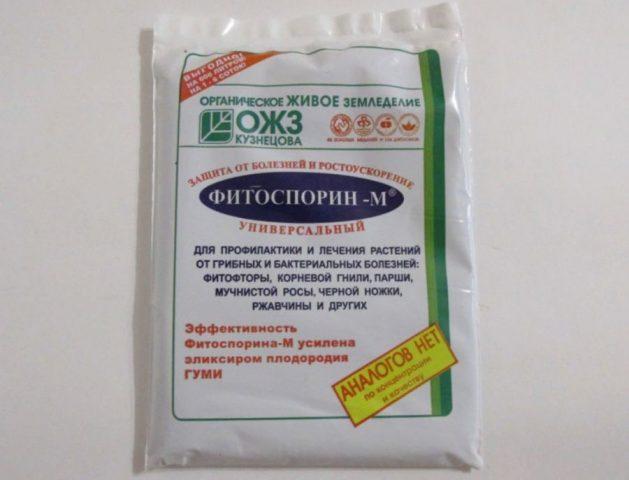
Fitosporin is most beneficial in the treatment of tomato cladosporiosis in the initial stages
Gamair
A biological agent based on soil bacteria suppresses the growth and development of the causative agent of cladosporiosis. Available in the form of dry powder and gray-brown tablets. It is characterized by low consumption during use.
For treatment, it is necessary to prepare a solution of ten tablets per 10 liters of clean liquid. The preparation is stirred until smooth, and then the tomatoes are irrigated over the leaves. Treatment for treatment purposes is best carried out before the formation of the ovary, but if necessary, it is allowed to use a biofungicide during the fruiting period.
If tomatoes become ill with cladosporiosis early, Gamair will be able to completely eliminate the symptoms of the disease.In mid-summer and when symptoms are pronounced, the drug is used mainly to slow down the development of the fungus.
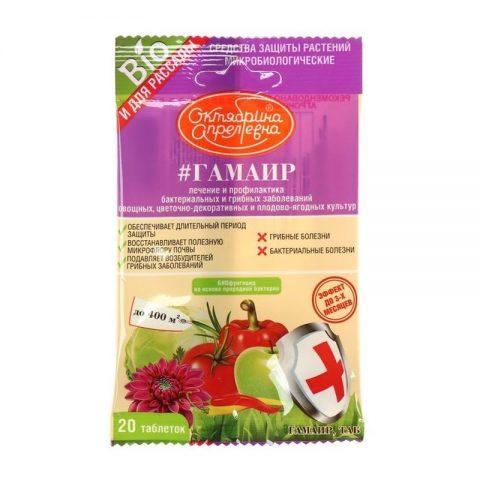
Gamair for tomatoes is used three times during the season with breaks of 15 days
Features of treatment in a greenhouse
Photos of cladosporiosis of tomato seedlings and their treatment show that the disease most often appears in the greenhouse. High temperature and humidity promote the development of fungus.
Treatment of the crop is carried out with the same drugs as in open ground. But when processing in a greenhouse, a number of additional conditions are observed:
- thoroughly ventilate the greenhouse after each spraying;
- control the degree of soil moisture and, if necessary, reduce the intensity of irrigation;
- maintain the temperature in the greenhouse at 25 °C.
When treating tomatoes in a greenhouse, it is also recommended to treat the walls of the structure against pathogenic microorganisms. This will avoid relapse of the disease.
Prevention of cladosporiosis of tomatoes
Measures to combat cladosporiosis on tomatoes in a greenhouse and in open soil do not always bring good results. It is recommended to focus on disease prevention. In particular:
- avoid waterlogging the soil under tomato bushes;
- ensure high-quality ventilation of plantings;
- promptly remove plant debris from the greenhouse and beds;
- avoid sudden changes in temperature and humidity;
- maintain at least a minimum distance between bushes.
When growing tomatoes, it is necessary to follow the rules of crop rotation. Tomato bushes are planted in a new place every season. It is allowed to return the crop to its original site only after three years.
Tillage
The risk of brown spot on tomato seedlings can be minimized by annual soil treatment. It is carried out in the autumn, the algorithm looks like this:
- All remnants of tops are removed from the site and burned in the far corner of the garden.
- The soil is dug up to a depth of at least 15 cm.
- Prepare a dark pink solution of potassium permanganate or Bordeaux mixture 3%.
- Sprinkle the resulting product onto the soil for disinfection purposes.
After disinfection, it is advisable to treat the soil with Baktofit, Baikal EM-1 or Trichodermin. The products will help restore beneficial microflora in the soil that were damaged by the use of antiseptics.
Seed disinfection
Fungicides against tomato cladosporiosis can be used not only to treat bushes, but also to treat planting material. Before sowing the crop for seedlings, it is recommended to soak the seeds in an antifungal solution. The following scheme can be used:
- Mix 1.5 Fitosporin powder in 100 ml of warm water.
- Leave the solution to stand for a couple of hours so that the natural bacteria in the composition have time to activate.
- Dip tomato seeds into the liquid and leave for two hours.
Pre-planting treatment will strengthen the crop’s immunity and make it more resistant to any fungi.
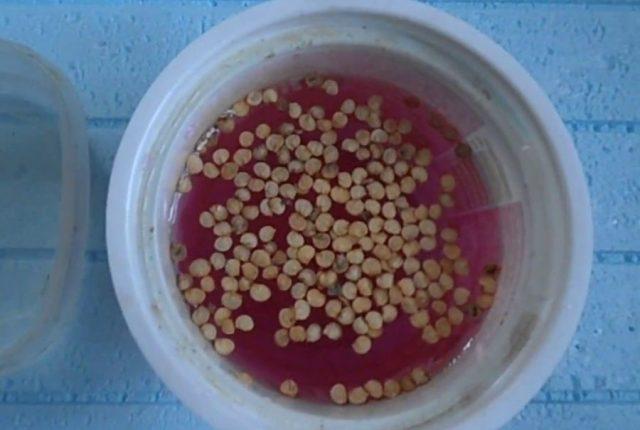
Instead of Fitosporin, a light pink solution of manganese can be used to disinfect tomato seeds.
Tomatoes resistant to cladosporiosis
Tomatoes with high immunity cause the least problems when growing. Popular types include:
- Vezha. The indeterminate early variety is intended for cultivation in greenhouses; it produces round or flattened fruits weighing up to 120 g.
Tomato Vezha has a universal purpose
- Pink Paradise.The mid-season variety yields its harvest 3.5 months after germination. Tomato fruits are flat-round, slightly ribbed, rich pink in color.
Pink Paradise tomatoes reach 200 g in weight
- Delicacy. A determinate tomato ripens within 110 days after seedlings are formed. Suitable for open ground and greenhouses, it bears pink-red fruits with good taste.
Tomato Delicacy produces up to 16 kg of fruit per 1 m2
Even hardy varieties can be affected by cladosporiosis if agricultural practices are violated. When growing crops, you must carefully follow the rules for preventing the disease.
Conclusion
Description and treatment of tomato cladosporiosis show that treatment is necessary when the first symptoms of the disease occur. A neglected fungus is quite difficult to eliminate; it manages to destroy the crop.
Reviews about the treatment of cladosporiosis on tomatoes
